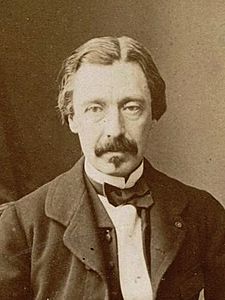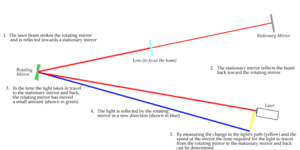Léon Foucault facts for kids
Quick facts for kids
Léon Foucault
|
|
|---|---|

Photograph by Bertall & Cie
|
|
| Born |
Jean Bernard Léon Foucault
18 September 1819 |
| Died | 11 February 1868 (aged 48) |
| Resting place | Montmartre Cemetery |
| Nationality | French |
| Alma mater | University of Paris |
| Known for | Foucault pendulum Foucault's currents Foucault knife-edge test Fizeau–Foucault apparatus Glan–Foucault prism Diurnal motion Gyroscope Catadioptric systems Silvering process |
| Awards | Copley Medal (1855) FRS (1864) |
| Scientific career | |
| Fields | Physics |
| Institutions | Paris Observatory |
Jean Bernard Léon Foucault (born September 18, 1819 – died February 11, 1868) was a French physicist. He is famous for several important discoveries and inventions.
Foucault is best known for creating the Foucault pendulum. This special device clearly showed that the Earth spins on its axis. He also measured the speed of light very accurately. In addition, he discovered eddy currents and was the person who named the gyroscope.
Contents
Early Life and Studies
Léon Foucault was born in Paris, France, on September 18, 1819. His father was a publisher. Léon was mostly taught at home.
He first studied medicine, but he didn't like seeing blood. So, he decided to switch to physics instead. For three years, he worked as an assistant to Alfred Donné. Donné taught about tiny parts of the body.
Foucault also worked with another scientist, Hippolyte Fizeau. Together, they studied how bright the sun's light was. They compared it to light from other sources, like arc lamps. They also looked at how different types of light rays interacted with each other.
In 1849, Foucault showed something important about light. He proved that dark lines (absorption lines) and bright lines (emission lines) in light happen because of the same material. The difference depends on the temperature of the light source.
Key Discoveries and Inventions
In 1850, Foucault did a famous experiment to measure the speed of light. He used a device called the Fizeau–Foucault apparatus. This experiment showed that light travels slower through water than through air. This was a big deal because it helped prove that light acts like a wave, not just tiny particles.
A year later, in 1851, Foucault gave a clear demonstration of the Earth's rotation. He did this using a very long, heavy pendulum. He hung it from the roof of the Panthéon, Paris in Paris. As the pendulum swung, its swing plane slowly turned. This turning showed that the Earth itself was rotating underneath it. This experiment was a huge success and amazed people everywhere. "Foucault pendulums" were then set up in many major cities.
The next year, he used and named the gyroscope. This device also showed the Earth's rotation in a simpler way. In 1855, Foucault received the Copley Medal from the Royal Society for his amazing experiments. He also became a physicist at the imperial observatory in Paris.
In September 1855, Foucault made another discovery. He found that if you spin a copper disc between the poles of a magnet, it becomes harder to turn. The disc also gets hot. This happens because of electric currents created inside the metal. He called these "eddy currents" or "Foucault currents."
In 1857, Foucault invented a special device for light called a polarizer. The next year, he created a way to test the mirrors used in reflecting telescopes. This "Foucault knife-edge test" helped telescope makers check if their mirrors were perfectly shaped. Before this, it was very hard to know if a telescope mirror was good. This test is still used today, especially by people who make their own telescopes.
In 1862, Foucault used a spinning mirror to measure the speed of light again. He found it to be 298,000 km per s. This was very close to the speed we accept today!
Later Career and Legacy
In 1862, Foucault became a member of the Bureau des Longitudes. He also received an honor called the Legion of Honour. He joined the Royal Society of London in 1864.
Foucault also worked on improving other inventions. For example, he experimented with a device that controls engines called a centrifugal governor. He wanted to make it spin at a constant speed. He also found a way to put a thin layer of silver on telescope lenses. This allowed people to look at the sun without hurting their eyes.
Foucault's most important scientific papers were published between 1847 and 1869.
Death and Remembrance
Léon Foucault passed away on February 11, 1868, in Paris. He was buried in the Montmartre Cemetery.
To honor him, an asteroid was named 5668 Foucault. His name is also one of the 72 names carved on the Eiffel Tower in Paris.
See also
 In Spanish: Léon Foucault para niños
In Spanish: Léon Foucault para niños
- Foucault pendulum vector diagrams
- Schlieren
Images for kids



